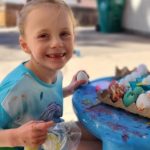Kora
 Kora has always been a gift to her parents, starting from the moment of her arrival on December 25th.
Kora has always been a gift to her parents, starting from the moment of her arrival on December 25th.
In her first few weeks of life, Kora struggled with acid reflux and major spit up. We lived by the five Ss (Swaddle, Side-stomach position, Shush, Swing, Suck) to soothe her somewhat cranky nature. Thankfully, Kora grew out of most of these issues by around three months and was, by all accounts, a normal, healthy baby. She hit milestone after milestone— rolling over, sitting up, crawling around 8 months and pulling herself up on furniture shortly after that.
Some time between six and nine months, we noticed some different eye movements (we now know these to be nystagmus and hand tremors), and were referred to a neurologist. When she hadn’t progressed to walking by 18 months, we finally went in for an MRI.
Following the MRI, we learned that Kora had a delay in myelination in her brain. That was the first time we heard the term leukodystrophy. When googling it, results showed a broad range of disorders all having to do with the white matter of the brain and myelin formation. But none of these seemed to match Kora.
With the MRI results and no real diagnosis, we were sent six hours from our home to the Colorado Children’s Hospital. While there Kora underwent more tests and met with both neurologists and genetic specialists. There were several hypotheses around what she had, including Leigh’s syndrome. At the time, I was also pregnant with our second child, and was fielding questions around whether I would continue my pregnancy if Kora’s diagnosis held serious implications for the health of our second child.
A few days after coming home, we received a call from the neurologist. He had studied under Adeline Vanderver, MD, one of the top researchers in the country for leukodystrophies. This neurologist told us of a clinical study that included a free full genome sequencing, which our insurance had denied. We sent off all of the blood work to the LeukoSEQ program and waited.
As we waited, Kora was evaluated by the local health department to see if she qualified for any state assistance to help pay for medical costs and early intervention programs. At the time, she was on track for most all developmental milestones except for the fact that she couldn’t walk yet on her own. She didn’t qualify for any assistance, but we did start physical therapy around 20 months, and then occupational therapy a few years later.
After 6 months of waiting and just 2 weeks before Kora’s little brother was born, we received the genetic testing results—Kora had a POLR3A gene mutation, causing a lack of myelination. Her formal clinical diagnosis was TACH version of the POL III leukodystrophy, a very rare condition that has only been studied in a handful of people. After the diagnosis and much digging into this condition, I’ve come to learn that every child with POL III Leukodystrophy has a VERY different path.
Kora is now 6 years old. She has never been able to walk on her own, but that does not stop her from being as independent as she can be. She uses a walker, and still crawls a bit while at home. She can dress herself (when motivated), feeds herself, and does a ton independently. She’s in first grade now. Cognitively she needs extra time to learn things, but she works super hard at it. She has a very hard time with writing because of the tremors, but is improving more and more. She absolutely loves school and her friends there. Over the last year or so we have been really battling her over tone in her legs and toe walking, which has really affected her ability to balance and it feels like she has definitely lost some of her walking ability because of the over tone. Her nystagmus also makes it harder to read and do more fine motor activities.
Kora loves to play with her dolls (LOL dolls are her current obsession), builds with Magnatiles and is always extremely happy when she’s in the water. She charms just about everyone she meets, and is a lot of fun to be around. My greatest hope is that we are able to keep her as independent as possible throughout her life, and hopefully make things a little easier for her.
